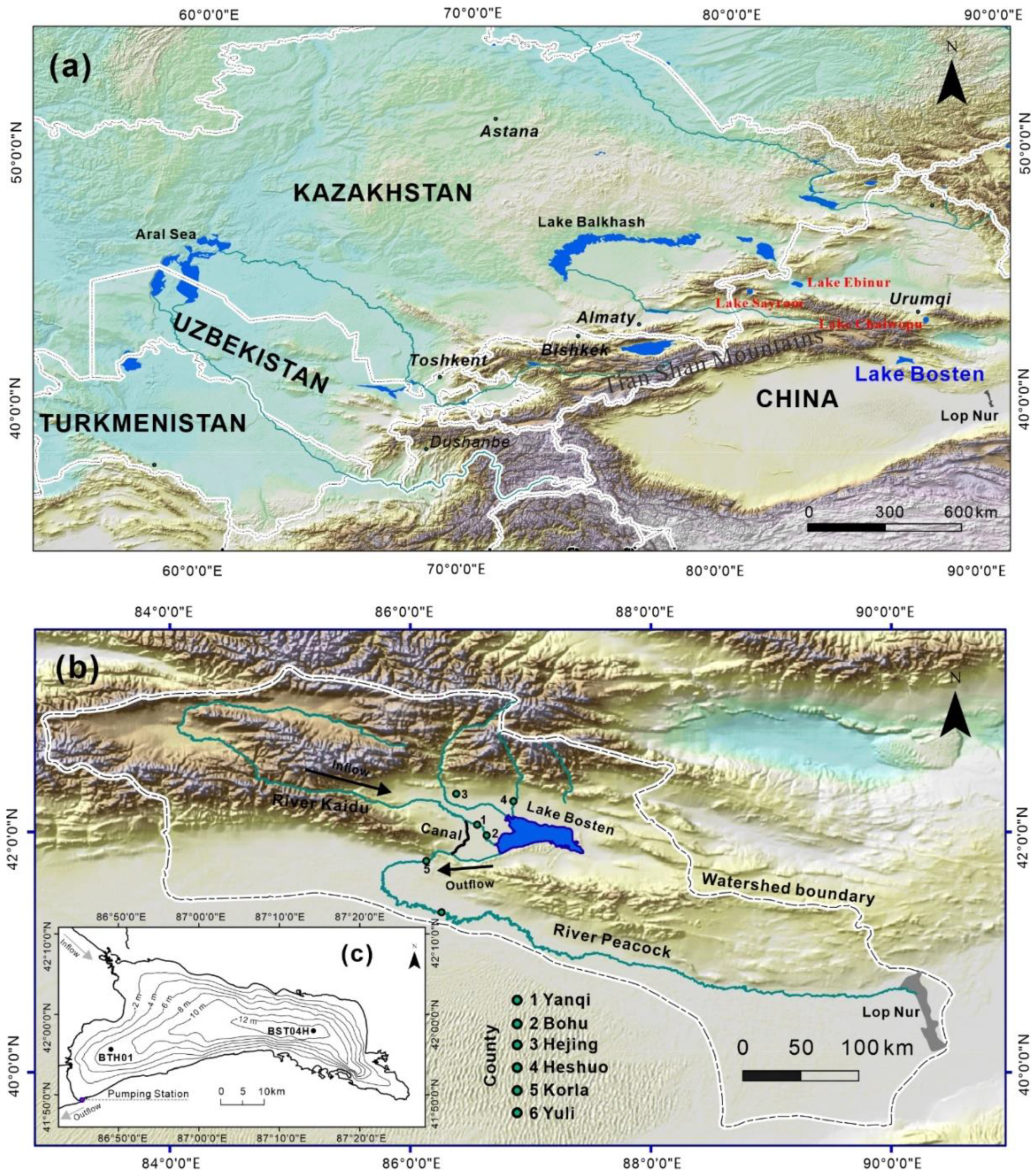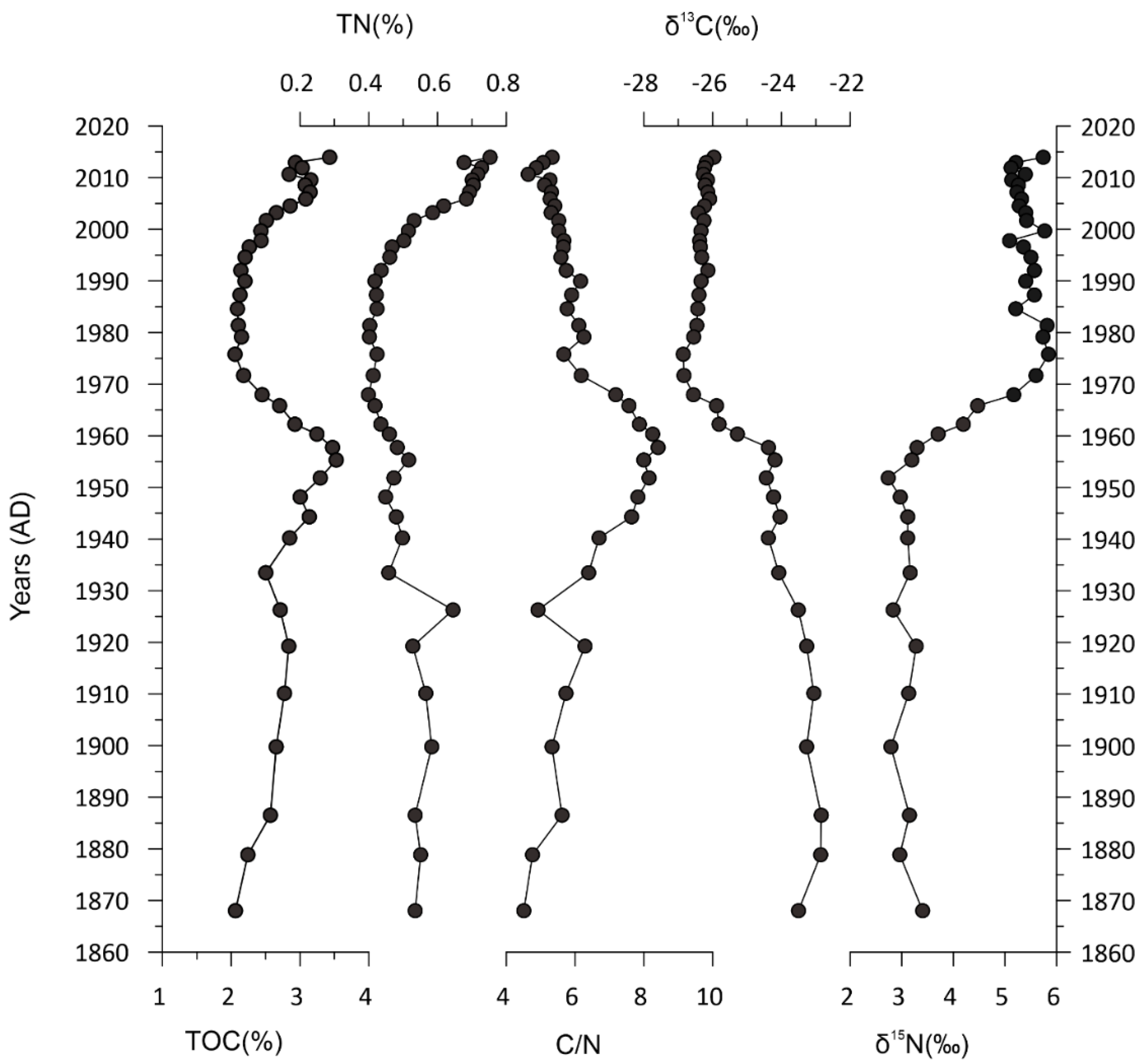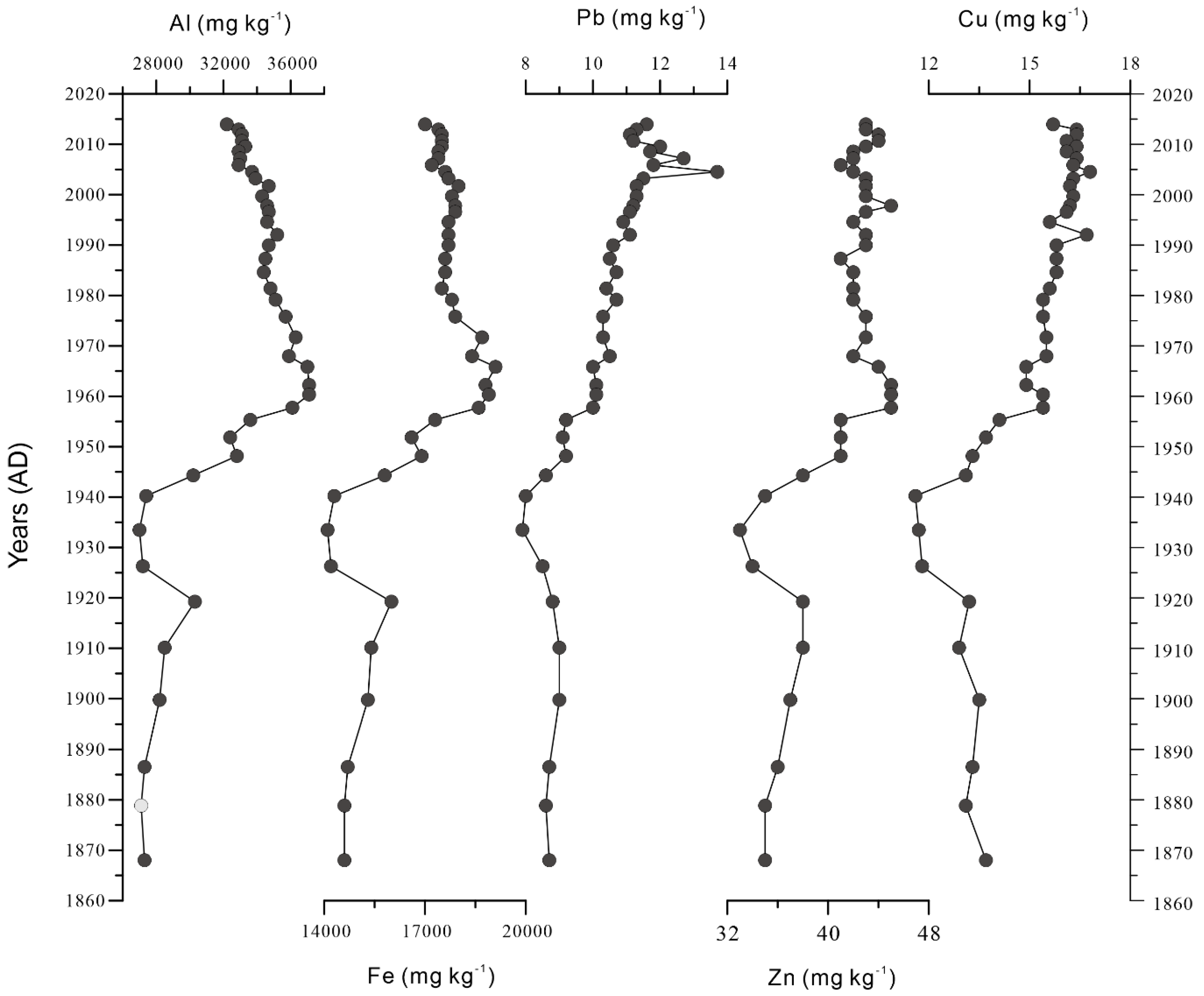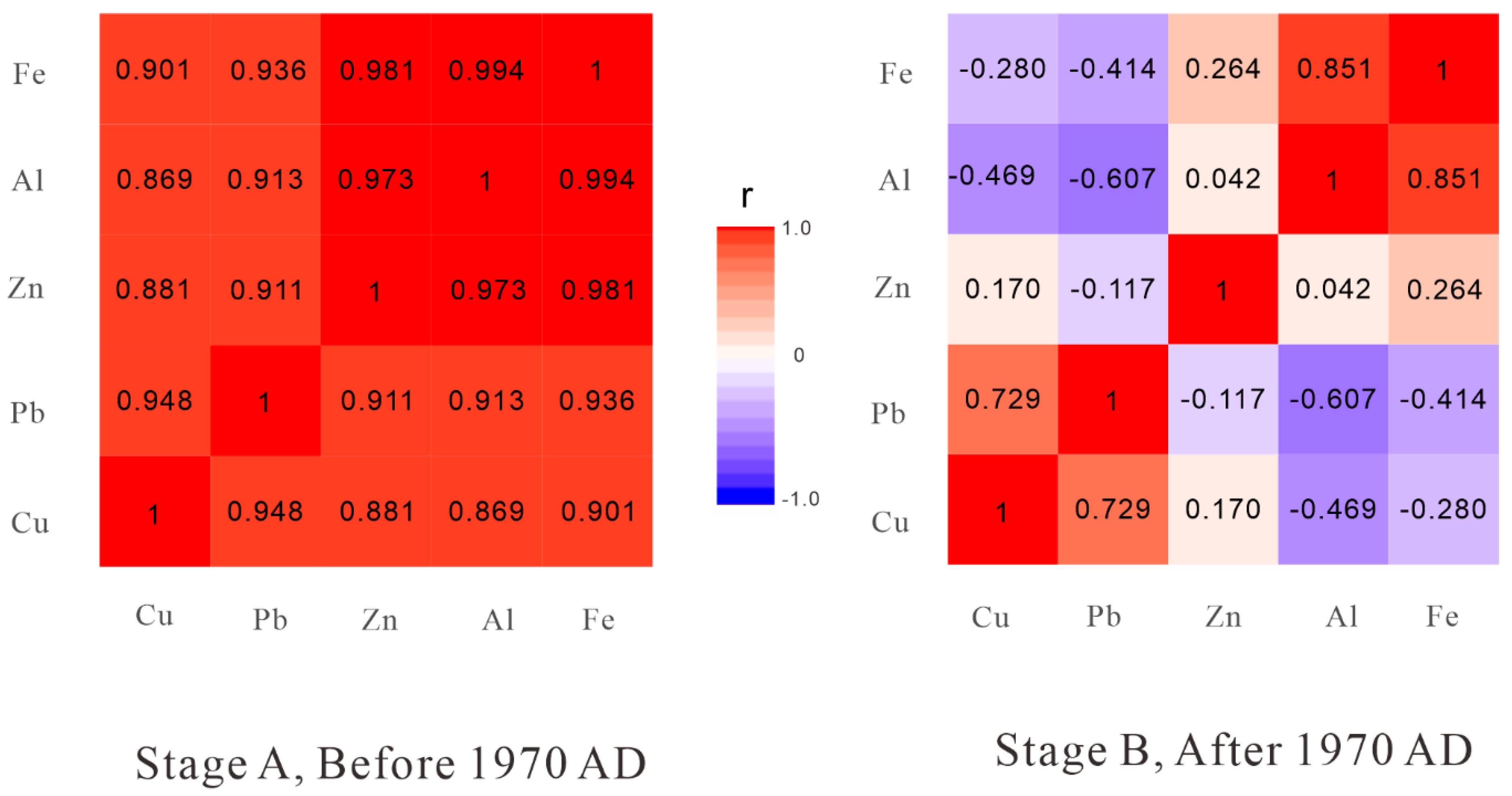Anthropogenic Influences on Environmental Changes of Lake Bosten, the Largest Inland Freshwater Lake in China
Abstract
1. Introduction
2. Materials and Methods
2.1. Geographic Setting
2.2. Sediment Sampling and Laboratory Analysis
2.3. Data Collection for Instrumental Records
3. Results and Discussions
3.1. The Chronology of the Bosten Lake Sediment Core
3.2. Organic Matter Proxies and Their Reponses to Anthropogenic Influences
3.3. Geochemical Elements and Their Reponses to Anthropogenic Influences
3.4. Regional Comparisions for Environmental Changes under Anthropogenic Influences in Central Asia
4. Conclusions
- (1)
- In this paper, sedimentary perspectives of the responses of different environmental proxies in sediments to human activities were anisochronous, and the complexity of sedimentological responses allows a single proxy to imply the history of human activity and is likely to be limited by regional human conditions.
- (2)
- The average C/N ratio in the sediments of Lake Bosten suggested that the organic matter in lake sediments mainly comes from aquatic plants. The stable isotope δ13Corg suggested changes in the composition of aquatic plants in lakes, which is closely related to the significant decline in the water levels and increased water salinity caused by enhanced water demands. The geochemical proxies of lake sediments did not respond to the changes since the late 1980s with increased water levels and improved water quality.
- (3)
- Human activities have had an important influence on the source of terrigenous clastic materials in the lacustrine sediments of Lake Bosten. The heavy metals (Cu and Pb) in Stage A, that is, from 1970, are not correlated positively with Al (which is mainly derived from erosion/catchment soils), reflecting enhanced human impacts.
- (4)
- According to the regional comparison, the period of significant enhancement of human activity recorded by the Bosten Lake sediment in the south of Tianshan is later than that in the north of Tianshan.
- (5)
- In areas with similar natural backgrounds, the evolution of lakes (Lake Bosten and theAral Sea) have completely different forms under the intervention of human activities, reflecting that the influence mode and intensity of human activities must be controlled. This also has significant implications for the protection of the ecological environment and the realization of sustainable development in arid regions.
Author Contributions
Funding
Acknowledgments
Conflicts of Interest
References
- Lioubimtseva, E.; Henebry, G.M. Climate and environmental change in arid Central Asia: Impacts, vulnerability, and adaptations. J. Arid Environ. 2009, 73, 963–977. [Google Scholar] [CrossRef]
- Chen, F.; Huang, W.; Jin, L.; Chen, J.; Wang, J. Spatiotemporal precipitation variations in the arid Central Asia in the context of global warming. Sci. China Ser. D Earth Sci. 2011, 54, 1812–1821. [Google Scholar] [CrossRef]
- Wilkinson, B.H. Humans as geologic agents: A deep-time perspective. Geology 2005, 33, 161–164. [Google Scholar] [CrossRef]
- Price, S.J.; Ford, J.R.; Cooper, A.H.; Neal, C. Humans as major geological and geomorphological agents in the Anthropocene: The significance of artificial ground in Great Britain. Philos. Trans. R. Soc. A Math. Phys. Eng. Sci. 2011, 369, 1056–1084. [Google Scholar] [CrossRef]
- Chen, X.; Bai, J.; Li, X.; Luo, G.; Li, J.; Li, B.L. Changes in land use/land cover and ecosystem services in Central Asia during 1990–2009. Curr. Opin. Environ. Sustain. 2013, 5, 116–127. [Google Scholar] [CrossRef]
- Karthe, D.; Chalov, S.; Borchardt, D. Water resources and their management in central Asia in the early twenty first century: Status, challenges and future prospects. Environ. Earth Sci. 2015, 73, 487–499. [Google Scholar] [CrossRef]
- Deng, H.; Chen, Y. Influences of recent climate change and human activities on water storage variations in Central Asia. J. Hydrol. 2017, 544, 46–57. [Google Scholar] [CrossRef]
- Bai, J.; Chen, X.; Li, J.; Yang, L.; Fang, H. Changes in the area of inland lakes in arid regions of central Asia during the past 30 years. Environ. Monit. Assess. 2011, 178, 247–256. [Google Scholar] [CrossRef]
- Lewis, S.L.; Maslin, M.A. Defining the Anthropocene. Nature 2015, 519, 171–180. [Google Scholar] [CrossRef]
- Dirzo, R.; Young, H.S.; Galetti, M.; Ceballos, G.; Isaac, N.J.B.; Collen, B. Defaunation in the Anthropocene. Science 2014, 345, 401. [Google Scholar] [CrossRef]
- Ruddiman, W.F. The Anthropocene. Annu. Rev. Earth Planet. Sci. 2013, 41, 45–68. [Google Scholar] [CrossRef]
- Dearing, J.A.; Battarbee, R.W.; Dikau, R.; Larocque, I.; Oldfield, F. Human–environment interactions: Learning from the past. Reg. Environ. Chang. 2006, 6, 1–16. [Google Scholar] [CrossRef]
- Mills, K.; Schillereff, D.; Saulnier-Talbot, É.; Gell, P.; Anderson, N.J.; Arnaud, F.; Dong, X.; Jones, M.; McGowan, S.; Massaferro, J.; et al. Deciphering long-term records of natural variability and human impact as recorded in lake sediments: A palaeolimnological puzzle. Wiley Interdiscip. Rev. Water 2017, 4, e1195. [Google Scholar] [CrossRef]
- Wolff, C.; Plessen, B.; Dudashvilli, A.S.; Breitenbach, S.F.M.; Cheng, H.; Edwards, L.R.; Strecker, M.R. Precipitation evolution of Central Asia during the last 5000 years. Holocene 2016, 27, 142–154. [Google Scholar] [CrossRef]
- Zhao, J.; An, C.-B.; Huang, Y.; Morrill, C.; Chen, F.-H. Contrasting early Holocene temperature variations between monsoonal East Asia and westerly dominated Central Asia. Quat. Sci. Rev. 2017, 178, 14–23. [Google Scholar] [CrossRef]
- Chen, F.-H.; Chen, J.-H.; Holmes, J.; Boomer, I.; Austin, P.; Gates, J.B.; Wang, N.-L.; Brooks, S.J.; Zhang, J.-W. Moisture changes over the last millennium in arid central Asia: A review, synthesis and comparison with monsoon region. Quat. Sci. Rev. 2010, 29, 1055–1068. [Google Scholar] [CrossRef]
- Li, Y.; Qiang, M.; Zhang, J.; Huang, X.; Zhou, A.; Chen, J.; Wang, G.; Zhao, Y. Hydroclimatic changes over the past 900 years documented by the sediments of Tiewaike Lake, Altai Mountains, Northwestern China. Quat. Int. 2017, 452, 91–101. [Google Scholar] [CrossRef]
- Lan, J.; Xu, H.; Sheng, E.; Yu, K.; Wu, H.; Zhou, K.; Yan, D.; Ye, Y.; Wang, T. Climate changes reconstructed from a glacial lake in High Central Asia over the past two millennia. Quat. Int. 2017, 487, 43–53. [Google Scholar] [CrossRef]
- Chiba, T.; Endo, K.; Sugai, T.; Haraguchi, T.; Kondo, R.; Kubota, J. Reconstruction of Lake Balkhash levels and precipitation/evaporation changes during the last 2000 years from fossil diatom assemblages. Quat. Int. 2016, 397, 330–341. [Google Scholar] [CrossRef]
- Ma, L.; Wu, J.; Yu, H.; Zeng, H.; Abuduwaili, J. The Medieval Warm Period and the Little Ice Age from a sediment record of Lake Ebinur, northwest China. Boreas 2011, 40, 518–524. [Google Scholar] [CrossRef]
- Ma, L.; Wu, J.; Abuduwaili, J. Climate and environmental changes over the past 150 years inferred from the sediments of Chaiwopu Lake, central Tianshan Mountains, northwest China. Int. J. Earth Sci. 2013, 102, 959–967. [Google Scholar] [CrossRef]
- Liu, W.; Ma, L.; Wu, J.; Abuduwaili, J. Environmental variability and human activity over the past 140 years documented by sediments of Ebinur Lake in arid central Asia. J. Limnol. 2017, 76, 534–545. [Google Scholar] [CrossRef]
- Liu, W.; Wu, J.; Ma, L.; Zeng, H. A 200-year sediment record of environmental change from Lake Sayram, Tianshan Mountains in China. GFF 2014, 136, 548–555. [Google Scholar] [CrossRef]
- Liu, W.; Wu, J.; Pan, X. A 100-year record of climate change and human activities inferred from the geochemical composition of sediments in Chaiwopu Lake, arid northwest China. J. Limnol. 2016, 75, 297–304. [Google Scholar] [CrossRef]
- Chen, F.; Yu, Z.; Yang, M.; Ito, E.; Wang, S.; Madsen, D.B.; Huang, X.; Zhao, Y.; Sato, T.; Birks, J.B.; et al. Holocene moisture evolution in arid central Asia and its out-of-phase relationship with Asian monsoon history. Quat. Sci. Rev. 2008, 27, 351–364. [Google Scholar] [CrossRef]
- Wünnemann, B.; Mischke, S.; Chen, F. A Holocene sedimentary record from Bosten Lake, China. Palaeogeogr. Palaeoclimatol. Palaeoecol. 2006, 234, 223–238. [Google Scholar] [CrossRef]
- Zhang, G.; Xie, H.; Yao, T.; Kang, S. Water balance estimates of ten greatest lakes in China using ICESat and Landsat data. Chin. Sci. Bull. 2013, 58, 3815–3829. [Google Scholar] [CrossRef]
- Guo, M.; Wu, W.; Zhou, X.; Chen, Y.; Li, J. Investigation of the dramatic changes in lake level of the Bosten Lake in northwestern China. Theor. Appl. Climatol. 2015, 119, 341–351. [Google Scholar] [CrossRef]
- Zuo, Q.; Dou, M.; Chen, X.I.; Zhou, K. Physically-based model for studying the salinization of Bosten Lake in China. Hydrol. Sci. J. 2006, 51, 432–449. [Google Scholar] [CrossRef]
- Wang, X.; Gong, P.; Zhao, Y.; Xu, Y.; Cheng, X.; Niu, Z.; Luo, Z.; Huang, H.; Sun, F.; Li, X. Water-level changes in China’s large lakes determined from ICESat/GLAS data. Remote Sens. Environ. 2013, 132, 131–144. [Google Scholar] [CrossRef]
- Rusuli, Y.; Li, L.; Ahmad, S.; Zhao, X. Dynamics model to simulate water and salt balance of Bosten Lake in Xinjiang, China. Environ. Earth Sci. 2015, 74, 2499–2510. [Google Scholar] [CrossRef]
- Xiao, M.; Wu, F.; Liao, H.; Li, W.; Lee, X.; Huang, R. Characteristics and distribution of low molecular weight organic acids in the sediment porewaters in Bosten Lake, China. J. Environ. Sci. 2010, 22, 328–337. [Google Scholar] [CrossRef]
- Zhang, C.; Mischke, S.; Zheng, M.; Prokopenko, A.; Guo, F.; Feng, Z. Carbon and Oxygen Isotopic Composition of Surface-Sediment Carbonate in Bosten Lake (Xinjiang, China) and its Controlling Factors. Acta Geol. Sin. 2009, 83, 386–395. [Google Scholar] [CrossRef]
- Lei, X.; Lu, J.; Liu, Z.; Tong, Y.; Li, S. Concentration and distribution of antibiotics in water–sediment system of Bosten Lake, Xinjiang. Environ. Sci. Pollut. Res. 2015, 22, 1670–1678. [Google Scholar] [CrossRef]
- Liu, Y.; Mu, S.; Bao, A.; Zhang, D.; Pan, X. Effects of salinity and (an)ions on arsenic behavior in sediment of Bosten Lake, Northwest China. Environ. Earth Sci. 2015, 73, 4707–4716. [Google Scholar] [CrossRef]
- Chen, J.; Zhang, E.; Brooks, S.J.; Huang, X.; Wang, H.; Liu, J.; Chen, F. Relationships between chironomids and water depth in Bosten Lake, Xinjiang, northwest China. J. Paleolimnol. 2014, 51, 313–323. [Google Scholar] [CrossRef]
- Huang, X.Z.; Chen, F.H.; Fan, Y.X.; Yang, M.L. Dry late-glacial and early Holocene climate in arid central Asia indicated by lithological and palynological evidence from Bosten Lake, China. Quat. Int. 2009, 194, 19–27. [Google Scholar] [CrossRef]
- Mischke, S.; Wünnemann, B. The Holocene salinity history of Bosten Lake (Xinjiang, China) inferred from ostracod species assemblages and shell chemistry: Possible palaeoclimatic implications. Quat. Int. 2006, 154, 100–112. [Google Scholar] [CrossRef]
- Yu, Z.; Wang, X.; Fan, H. Spatial Distribution of Organic Carbon in Surface Sediment of Bosten Lake. In Carbon Cycle in the Changing Arid Land of China: Yanqi Basin and Bosten Lake; Wang, X., Yu, Z., Wang, J., Zhang, J., Eds.; Springer: Singapore, 2018; pp. 103–115. [Google Scholar] [CrossRef]
- Yu, Z.; Wang, X.; Zhao, C.; Lan, H. Carbon burial in Bosten Lake over the past century: Impacts of climate change and human activity. Chem. Geol. 2015, 419, 132–141. [Google Scholar] [CrossRef]
- Wurtsbaugh, W.A.; Miller, C.; Null, S.E.; DeRose, R.J.; Wilcock, P.; Hahnenberger, M.; Howe, F.; Moore, J. Decline of the world’s saline lakes. Nat. Geosci. 2017, 10, 816. [Google Scholar] [CrossRef]
- Wu, J.; Ma, L.; Zeng, H. Water Quality and Quantity Characteristics and Its Evolution in Lake Bosten, Xinjiang over the Past 50 Years. Sci. Geogr. Sin. 2013, 33, 231–237. [Google Scholar] [CrossRef]
- Salamat, A.U.; Abuduwaili, J.; Shaidyldaeva, N. Impact of climate change on water level fluctuation of Issyk-Kul Lake. Arab. J. Geosci. 2015, 8, 5361–5371. [Google Scholar] [CrossRef]
- Ma, L.; Wu, J.; Liu, W.; Abuduwaili, J. Distinguishing between anthropogenic and climatic impacts on lake size: A modeling approach using data from Ebinur Lake in arid northwest China. J. Limnol. 2014, 73, 148–155. [Google Scholar] [CrossRef]
- Chen, F.; Huang, X.; Zhang, J.; Holmes, J.A.; Chen, J. Humid Little Ice Age in arid central Asia documented by Bosten Lake, Xinjiang, China. Sci. China Ser. D Earth Sci. 2006, 49, 1280–1290. [Google Scholar] [CrossRef]
- Zhang, J.; Zhou, C.; Li, J. Spatial pattern and evolution of oases in the Yanqi Basin, Xinjiang. Geogr. Res. 2006, 25, 350–358. [Google Scholar] [CrossRef]
- Huang, T.; Pang, Z. Changes in groundwater induced by water diversion in the Lower Tarim River, Xinjiang Uygur, NW China: Evidence from environmental isotopes and water chemistry. J. Hydrol. 2010, 387, 188–201. [Google Scholar] [CrossRef]
- Wu, J.; Liu, W.; Zeng, H.; Ma, L.; Bai, R. Water Quantity and Quality of Six Lakes in the Arid Xinjiang Region, NW China. Environ. Process. 2014, 1, 115–125. [Google Scholar] [CrossRef]
- Zhou, H.; Chen, Y.; Perry, L.; Li, W. Implications of climate change for water management of an arid inland lake in Northwest China. Lake Reserv. Manag. 2015, 31, 202–213. [Google Scholar] [CrossRef]
- Yu, Z.; Wang, X.; Chengyi, Z.; Haiyan, L.A.N. Source characterization of organic carbon using elemental, isotopic and n-alkanes proxies in surface sediment from Lake Bosten, Xinjiang. J. Lake Sci. 2015, 27, 983–990. [Google Scholar] [CrossRef]
- Palma, P.; Ledo, L.; Alvarenga, P. Assessment of trace element pollution and its environmental risk to freshwater sediments influenced by anthropogenic contributions: The case study of Alqueva reservoir (Guadiana Basin). Catena 2015, 128, 174–184. [Google Scholar] [CrossRef]
- Shen, J.; Liu, X.; Wang, S.; Ryo, M. Palaeoclimatic changes in the Qinghai Lake area during the last 18,000 years. Quat. Int. 2005, 136, 131–140. [Google Scholar] [CrossRef]
- Ermakhanov, Z.K.; Plotnikov, I.S.; Aladin, N.V.; Micklin, P. Changes in the Aral Sea ichthyofauna and fishery during the period of ecological crisis. Lakes Reserv. Res. Manag. 2012, 17, 3–9. [Google Scholar] [CrossRef]
- Shibuo, Y.; Jarsjö, J.; Destouni, G. Hydrological responses to climate change and irrigation in the Aral Sea drainage basin. Geophys. Res. Lett. 2007, 34. [Google Scholar] [CrossRef]
- Yao, J.; Chen, Y.; Zhao, Y.; Yu, X. Hydroclimatic changes of Lake Bosten in Northwest China during the last decades. Sci. Rep. 2018, 8, 9118. [Google Scholar] [CrossRef]
- Glantz, M. Creeping Environmental Problems and Sustainable Development in the Aral Sea Basin; Cambridge University Press: Cambridge, UK, 1999. [Google Scholar]
- Liu, W.; Abuduwaili, A.; Ma, L. Geochemistry of major and trace elements and their environmental significances in core sediments from Bosten Lake, arid northwestern China. J. Limnol. 2019, 78, 201–209. [Google Scholar] [CrossRef]
- Appleby, P.G. Three decades of dating recent sediments by fallout radionuclides: A review. Holocene 2008, 18, 83–93. [Google Scholar] [CrossRef]
- Pennington, W.; Tutin, T.G.; Cambray, R.S.; Fisher, E.M. Observations on lake sediments using fallout 137Cs as a tracer. Nature 1973, 242, 324. [Google Scholar] [CrossRef]
- Meyers, P.A.; Ishiwatari, R. Lacustrine organic geochemistry—An overview of indicators of organic matter sources and diagenesis in lake sediments. Org. Geochem. 1993, 20, 867–900. [Google Scholar] [CrossRef]
- Teranes, J.L.; Bernasconi, S.M. The record of nitrate utilization and productivity limitation provided by δ15N values in lake organic matter—A study of sediment trap and core sediments from Baldeggersee, Switzerland. Limnol. Oceanogr. 2000, 45, 801–813. [Google Scholar] [CrossRef]
- Meyers, P.A.; Lallier-Vergés, E. Lacustrine Sedimentary Organic Matter Records of Late Quaternary Paleoclimates. J. Paleolimnol. 1999, 21, 345–372. [Google Scholar] [CrossRef]
- Contreras, S.; Werne, J.P.; Araneda, A.; Urrutia, R.; Conejero, C.A. Organic matter geochemical signatures (TOC, TN, C/N ratio, δ13C and δ15N) of surface sediment from lakes distributed along a climatological gradient on the western side of the southern Andes. Sci. Total Environ. 2018, 630, 878–888. [Google Scholar] [CrossRef] [PubMed]
- Kumar, A.; Hage-Hassan, J.; Baskaran, M.; Miller, C.J.; Selegean, J.P.; Creech, C.T. Multiple sediment cores from reservoirs are needed to reconstruct recent watershed changes from stable isotopes (δ13C and δ15N) and C/N ratios: Case studies from the mid-western United States. J. Paleolimnol. 2016, 56, 15–31. [Google Scholar] [CrossRef]
- Xu, H.; Ai, L.; Tan, L.; An, Z. Stable isotopes in bulk carbonates and organic matter in recent sediments of Lake Qinghai and their climatic implications. Chem. Geol. 2006, 235, 262–275. [Google Scholar] [CrossRef]
- Meyers, P.A.; Teranes, J.L. Sediment Organic Matter. In Tracking Environmental Change Using Lake Sediments: Physical and Geochemical Methods; Last, W.M., Smol, J.P., Eds.; Springer: Dordrecht, The Netherlands, 2001; pp. 239–269. [Google Scholar] [CrossRef]
- Fan, J.; Xiao, J.; Wen, R.; Zhang, S.; Wang, X.; Cui, L.; Yamagata, H. Carbon and nitrogen signatures of sedimentary organic matter from Dali Lake in Inner Mongolia: Implications for Holocene hydrological and ecological variations in the East Asian summer monsoon margin. Quat. Int. 2017, 452, 65–78. [Google Scholar] [CrossRef]
- Varrica, D.; Aiuppa, A.; Dongarrà, G. Volcanic and anthropogenic contribution to heavy metal content in lichens from Mt. Etna and Vulcano island (Sicily). Environ. Pollut. 2000, 108, 153–162. [Google Scholar] [CrossRef]
- Chakraborty, S.; Bhattacharya, T.; Singh, G.; Maity, J.P. Benthic macroalgae as biological indicators of heavy metal pollution in the marine environments: A biomonitoring approach for pollution assessment. Ecotoxicol. Environ. Saf. 2014, 100, 61–68. [Google Scholar] [CrossRef]
- Ma, L.; Abuduwaili, J.; Li, Y.; Ge, Y. Controlling Factors and Pollution Assessment of Potentially Toxic Elements in Topsoils of the Issyk-Kul Lake Region, Central Asia. Soil Sediment Contam. Int. J. 2018, 27, 147–160. [Google Scholar] [CrossRef]
- Massakbayeva, A.; Abuduwaili, J.; Issanova, G.; Bissenbayeva, S.; Issina, B. Temperature and Precipitation Trend in The Aral Sea and Aral Sea Region During 1960–2016. Bull. Natl. Acad. Sci. Repub. Kaz. 2019, 3, 6–15. [Google Scholar] [CrossRef]
- Ma, L.; Wu, J.; Abuduwaili, J. The climatic and hydrological changes and environmental responses recorded in lake sediments of Xinjiang, China. J. Arid Land 2011, 3, 1–8. [Google Scholar] [CrossRef][Green Version]
- Gaybullaev, B.; Chen, S.C.; Gaybullaev, G. The large Aral Sea water balance: A future prospective of the large Aral Sea depending on water volume alteration. Carbonates Evaporites 2014, 29, 211–219. [Google Scholar] [CrossRef]
- Gong, X.L.; Cui, Z.K.; Zhang, X.Y.; Wang, C.H. Complete mitochondrial DNA sequence of the endangered Tarim schizothoracin (Schizothorax biddulphi Günther). Mitochondrial DNA 2012, 23, 385–387. [Google Scholar] [CrossRef] [PubMed]
- Micklin, P. Aral Sea Basin Water Resources and the Changing Aral Water Balance. In The Aral Sea: The Devastation and Partial Rehabilitation of a Great Lake; Micklin, P., Aladin, N.V., Plotnikov, I., Eds.; Springer: Berlin/Heidelberg, Germany, 2014; pp. 111–135. [Google Scholar] [CrossRef]
- Micklin, P. The future Aral Sea: Hope and despair. Environ. Earth Sci. 2016, 75, 844. [Google Scholar] [CrossRef]
- Breckle, S.W.; Geldyeva, G.V. Dynamics of the Aral Sea in Geological and Historical Times. In Aralkum—A Man-Made Desert: The Desiccated Floor of the Aral Sea (Central Asia); Breckle, S.-W., Wucherer, W., Dimeyeva, L.A., Ogar, N.P., Eds.; Springer: Berlin/Heidelberg, Germany, 2012; pp. 13–35. [Google Scholar] [CrossRef]
- Pala, C. Once a Terminal Case, the North Aral Sea Shows New Signs of Life. Science 2006, 312, 183. [Google Scholar] [CrossRef] [PubMed][Green Version]
- Shen, H.; Abuduwaili, J.; Ma, L.; Samat, A. Remote sensing-based land surface change identification and prediction in the Aral Sea bed, Central Asia. Int. J. Environ. Sci. Technol. 2018. [Google Scholar] [CrossRef]





© 2020 by the authors. Licensee MDPI, Basel, Switzerland. This article is an open access article distributed under the terms and conditions of the Creative Commons Attribution (CC BY) license (http://creativecommons.org/licenses/by/4.0/).
Share and Cite
Liu, W.; Ma, L.; Abuduwaili, J. Anthropogenic Influences on Environmental Changes of Lake Bosten, the Largest Inland Freshwater Lake in China. Sustainability 2020, 12, 711. https://doi.org/10.3390/su12020711
Liu W, Ma L, Abuduwaili J. Anthropogenic Influences on Environmental Changes of Lake Bosten, the Largest Inland Freshwater Lake in China. Sustainability. 2020; 12(2):711. https://doi.org/10.3390/su12020711
Chicago/Turabian StyleLiu, Wen, Long Ma, and Jilili Abuduwaili. 2020. "Anthropogenic Influences on Environmental Changes of Lake Bosten, the Largest Inland Freshwater Lake in China" Sustainability 12, no. 2: 711. https://doi.org/10.3390/su12020711
APA StyleLiu, W., Ma, L., & Abuduwaili, J. (2020). Anthropogenic Influences on Environmental Changes of Lake Bosten, the Largest Inland Freshwater Lake in China. Sustainability, 12(2), 711. https://doi.org/10.3390/su12020711




